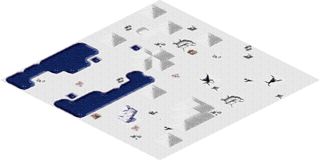Difference between revisions of "Arctic Terrain"
Papa Legba (talk | contribs) m |
Papa Legba (talk | contribs) m |
||
| Line 8: | Line 8: | ||
<br clear="all"> | <br clear="all"> | ||
==Battle Notes== | ==Battle Notes== | ||
| + | # Because it is so open, many commanders prefer to arctic terrain for 'training' missions. It is relatively easy to shoot down a UFO over the broad expanses of the icecaps, and then let the rookies hunt aliens out in the open. | ||
*The shortage of cover means that a "two step forwards, one step back" strategy can be very effective. This means that scouts should move forward until they sight the enemy, then let second-line shooters take those enemies down. Once the enemy is taken out, the scouts should fall back a short distance, forcing any other enemies to move forward on their own turn, burning up the enemy's time units and reducing their opportunities to fire. | *The shortage of cover means that a "two step forwards, one step back" strategy can be very effective. This means that scouts should move forward until they sight the enemy, then let second-line shooters take those enemies down. Once the enemy is taken out, the scouts should fall back a short distance, forcing any other enemies to move forward on their own turn, burning up the enemy's time units and reducing their opportunities to fire. | ||
*The open space will allow long-distance grenade tosses. | *The open space will allow long-distance grenade tosses. | ||
| + | *Because they are both so wide open, desert and arctic terrains are tactically very similar. | ||
==See Also== | ==See Also== | ||
[[Category:Terrain]] | [[Category:Terrain]] | ||
Revision as of 18:40, 29 December 2005
Aliens will land in the polar regions more often than you would suspect. They prefer flat, open snowfields. From the Geoscape, artic terrain looks snow-white.
The chief terrain features here will be low snowdrifts (usually lower than head height) and cracks in the icecap, where frigid water peeks through the surface. To avoid hypothermia, ground units should not attempt to cross standing water. Failsafes in both alien and X-Com hardware prevent flying units from crossing such water at ground level, for fear of being speared by angry narwhals. Be sure to rise at least a storey above the surface to cross.
There is little cover for alien or trooper. Enemies can be sighted from long distances, and sharpshooters can often place a shot clear across the battlefield. The effects of darknessseem, tp decrease somewhat here, due to the brightness of light reflected off snow and ice.
Battle Notes
- Because it is so open, many commanders prefer to arctic terrain for 'training' missions. It is relatively easy to shoot down a UFO over the broad expanses of the icecaps, and then let the rookies hunt aliens out in the open.
- The shortage of cover means that a "two step forwards, one step back" strategy can be very effective. This means that scouts should move forward until they sight the enemy, then let second-line shooters take those enemies down. Once the enemy is taken out, the scouts should fall back a short distance, forcing any other enemies to move forward on their own turn, burning up the enemy's time units and reducing their opportunities to fire.
- The open space will allow long-distance grenade tosses.
- Because they are both so wide open, desert and arctic terrains are tactically very similar.
